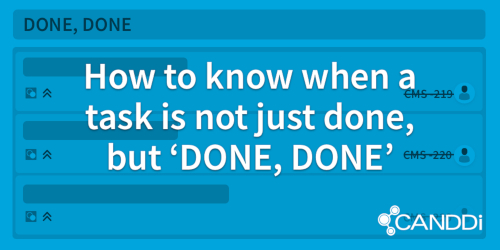Blog and News > marketing > Agile marketing: how to know when a task is not just done, but ‘done-done’
Agile marketing: how to know when a task is not just done, but ‘done-done’
In recent weeks on the CANDDi blog, we’ve shared with you our ‘agile’ approach to marketing. Most often applied to software development, agile techniques can also make sense in other settings. Make sure you’ve read our primer of how we apply agile principles to marketing before you continue with this post.

One part of agile that is important to understand is ‘Done.’ To software developers, this can become quite complicated, to the point where people talk about ‘Done/Done/Done/Done.’ But there’s no need for things to be that confusing in a marketing sprint.
As you know, we track the progress of our sprints in Atlassian’s Jira software. We push a card that represents an individual task across to the ‘done’ column when it’s completed. But when we first adopted agile, we found people were racing to complete their assigned tasks as quickly as possible.
It’s important to make progress at a fast pace, but not to rush. Putting a task in ‘done’ when it’s only been completed well enough for you to move on to the next thing isn’t good enough.
For example, writing this blog post was a task for me in a recent sprint. But if I’d rushed through it, finished my first draft and then marked it done, there would probably be spelling mistakes in here, maybe some factual errors and other bits I could improve upon. It would be technically ‘done,’ but it wouldn’t be ‘done-done.’
So, how do you make sure you complete all the tasks in your sprint while also making sure everything is done to the standard you can call it ‘done-done?’
Balancing pace and quality
Work quickly enough that you get all your tasks completed, but give yourself enough time to do a good job. If something’s worth doing, it’s worth doing right.
If you rush and don’t complete a job properly, you’ll have pain later. In the software development world, they call this ‘technical debt.’ They might hack together a solution to meet a deadline, but that will come back to bite them in the future when someone else comes along and tries to work with their poor code that only just achieves what it’s meant to. In marketing, the same principle applies.
As we’ve mentioned in the past, it all comes down to being strict about not overstretching yourselves in any one sprint. If you have lots of easy tasks lined up, but a couple of them take way longer to complete than intended, you’ve suddenly got a backlog. Manage expectations about how much you can reasonably complete in any one sprint, emphasize being properly ‘done.’ and you’ll stay on track.
And with that, this post is done-done.